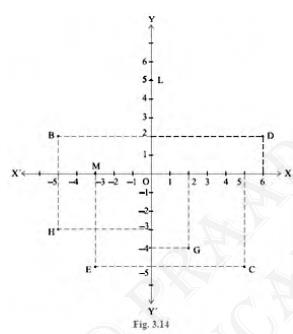Coordinate geometry class 9 extra questions || class 9 maths chapter 3 exercise 3.2 solutions || math class 9 chapter 3 exercise 3.2 || class 9 maths chapter 3 exercise 3.2 || rd sharma class 9 exercise 3.2 || exercise 3.2 class 9 math solutions
Explore comprehensive, step-by-step solutions to Class 9 Maths Chapter 3, Exercise 3.2, which focuses on understanding and applying the basics of Coordinate Geometry. This exercise helps students learn how to accurately plot points on the Cartesian plane and identify their coordinates. Each solution is presented with clarity and logical reasoning to strengthen students’ grasp of fundamental geometric concepts. By practicing these problems, learners develop confidence in spatial understanding, which is essential for solving more complex geometry topics in higher grades. For enhanced conceptual clarity and additional practice, students are encouraged to refer to the NCERT Exemplar Class 9 Maths problems.

coordinate geometry class 9 extra questions || class 9 maths chapter 3 exercise 3.2 solutions || math class 9 chapter 3 exercise 3.2 || class 9 maths chapter 3 exercise 3.2 || rd sharma class 9 exercise 3.2 || exercise 3.2 class 9 math solutions
Exercise 3.2
1. Write the answer of each of the following questions:
a) \(1^{\text{st}}\) quadrant \( (+x,+y) \)
b) \( 2^{\text {nd }} \) quadrant \( (-x,+y) \)
c) \( 3^{\text {rd }} \) quadrant \( (-x,-y) \)
d) \( 4^{\text {th }} \) quadrant \( (x,-y \) )
coordinate geometry class 9 extra questions || class 9 maths chapter 3 exercise 3.2 solutions || math class 9 chapter 3 exercise 3.2 || class 9 maths chapter 3 exercise 3.2 || rd sharma class 9 exercise 3.2 || exercise 3.2 class 9 math solutions
2. See Fig. 3.14, and write the following:

The coordinates of B
Then look at the vertical distance of point from origin. Distance measured to the right of origin is positive \( x \) axis. And distance measured to the top of origin is positive \(y\) axis. And similarly left and bottom shows negative \(x\) axis and negative \(y\) axis respectively.
The coordinates of B are \( (-5,2) \)
coordinate geometry class 9 extra questions || class 9 maths chapter 3 exercise 3.2 solutions || math class 9 chapter 3 exercise 3.2 || class 9 maths chapter 3 exercise 3.2 || rd sharma class 9 exercise 3.2 || exercise 3.2 class 9 math solutions

The coordinates of C
Then look at the vertical distance of point from origin. Distance measured to the right of origin is positive \( x \) axis. And distance measured to the top of origin is positive \(y\) axis. And similarly left and bottom shows negative \(x\) axis and negative \(y\) axis respectively.
\( (5,-5) \) is the coordinate of C .

The point identified by the coordinates \( (-3,-5) \)
Then look at the vertical distance of point from origin. Distance measured to the right of origin is positive \( x \) axis. And distance measured to the top of origin is positive \(y\) axis. And similarly left and bottom shows negative \(x\) axis and negative \(y\) axis respectively.
E is identified by the coordinates \( (-3,-5) \).

The point identified by the coordinates \((2, -4)\)
Then look at the vertical distance of point from origin. Distance measured to the right of origin is positive \( x \) axis. And distance measured to the top of origin is positive \(y\) axis. And similarly left and bottom shows negative \(x\) axis and negative \(y\) axis respectively.
G is the point identified by the coordinates \( (2,-4) \)

The abscissa of the point D
Then look at the vertical distance of point from origin. Distance measured to the right of origin is positive \( x \) axis. And distance measured to the top of origin is positive \(y\) axis. And similarly left and bottom shows negative \(x\) axis and negative \(y\) axis respectively.
Abscissa means \( x \) coordinate of point D . Hence, abscissa of the point \( D \) is 6

The ordinate of the point H
Then look at the vertical distance of point from origin. Distance measured to the right of origin is positive \( x \) axis. And distance measured to the top of origin is positive \(y\) axis. And similarly left and bottom shows negative \(x\) axis and negative \(y\) axis respectively.
Ordinate means y coordinate of point H . Hence, ordinate of point H is \(-3\)

The coordinates of the point L
Then look at the vertical distance of point from origin. Distance measured to the right of origin is positive \( x \) axis. And distance measured to the top of origin is positive \(y\) axis. And similarly left and bottom shows negative \(x\) axis and negative \(y\) axis respectively.
The coordinates of the point L is \( (0,5) \)

The coordinates of the point M
Then look at the vertical distance of point from origin. Distance measured to the right of origin is positive \( x \) axis. And distance measured to the top of origin is positive \(y\) axis. And similarly left and bottom shows negative \(x\) axis and negative \(y\) axis respectively.
The coordinates of the point M is \( (-3,0) \)

